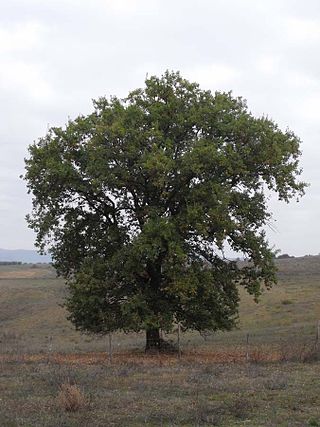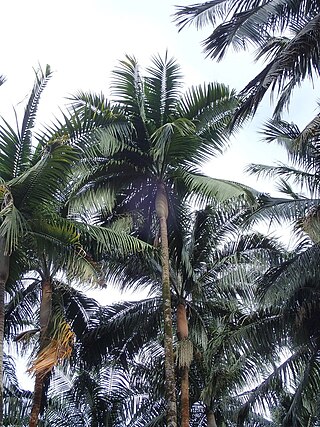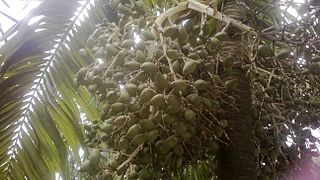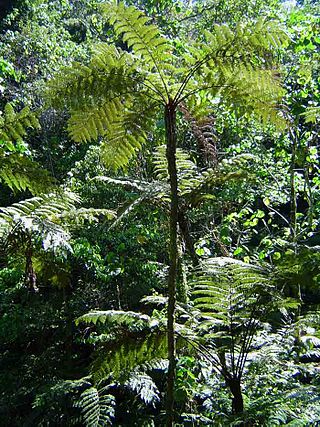
Arctostaphylos is a genus of plants comprising the manzanitas and bearberries. There are about 60 species of Arctostaphylos, ranging from ground-hugging arctic, coastal, and mountain shrub to small trees up to 6 m tall. Most are evergreen, with small oval leaves 1–7 cm long, arranged spirally on the stems. The flowers are bell-shaped, white or pale pink, and borne in small clusters of 2–20 together; flowering is in the spring. The fruit are small berries, ripening in the summer or autumn. The berries of some species are edible.

Arbutus is a genus of 12 accepted species of flowering plants in the family Ericaceae, native to temperate regions of the Mediterranean, western Europe, the Canary Islands and North America, and commonly called madrones or strawberry trees. The name Arbutus was taken by taxonomists from Latin, where it referred to the species now designated Arbutus unedo.

Quercus pubescens, commonly known as the downy oak, pubescent oak or Italian oak, is a species of white oak native to southern Europe and southwest Asia. It is found from northern Spain (Pyrenees) and France in the West to Turkey and the Caucasus in the East.

Acanthophoenix is a genus of flowering plants in the palm family from the Mascarene Islands in the Indian Ocean, where they are commonly called palmiste rouge. A genus long in flux, three species are currently recognized, though unsustainable levels of harvesting for their edible palm hearts have brought them all to near extinction in habitat. They are closely related to the Tectiphiala and Deckenia genera, differing in the shape of the staminate flower. The name combines the Greek words for "thorn" and "date palm".

Jacobaea maritima, commonly known as silver ragwort, is a perennial plant species in the genus Jacobaea in the family Asteraceae, native to the Mediterranean region. It was formerly placed in the genus Senecio, and is still widely referred to as Senecio cineraria; see the list of synonyms (right) for other names.

Pittosporum crassifolium, karo, stiffleaf cheesewood, kaikaro or kihiki is a relatively fast-growing large shrub or small tree with an erect, fastigiate growth habit. It is native to New Zealand.
George M. Diggs, Jr. holds a Ph.D. in biology from the University of Wisconsin–Madison. He is Professor of Biology at Austin College in Sherman, Texas. He is a specialist in the systematics of the plant genera Comarostaphylis and Arctostaphylos (Ericaceae). This recent research has focused on the floras of North Central and Eastern Texas.

Comarostaphylis is a genus of shrubs in the heath family native to the Americas from California in the United States to Panama. These are hairy, glandular shrubs to small trees with shreddy bark, often quite similar to their close relatives, the manzanitas.
Nenga is a monoecious genus of flowering plant in the palm family. It is native to Southeast Asia and commonly called pinang palm. The genus name is based on a corruption of a Javanese term for a plant now classified within Pinanga.

Allagoptera caudescens is a species of flowering plant in the palm family endemic to Brazil, where it is known as buri palm. The older name Polyandrococos combines the Greek words for "many" and "anther" with the name of another palm genus Cocos, and the epithet is Latin for "bearlike", referring to the hairy tomentum. It was formerly classified as Polyandrococos caudescens, the only species in the genus Polyandrococos.

Ptychococcus is a monoecious genus of flowering plant in the palm family from New Guinea and the Solomon Islands. They are closely related to Ptychosperma, only differentiated by the seed shape and endocarp type. The name is a combination of the Greek for "fold" and the Latin for "berry".

Prunus tomentosa is a species of Prunus native to northern and western China, Korea, Mongolia, and possibly northern India. Common names for Prunus tomentosa include Nanjing cherry, Korean cherry, Manchu cherry, downy cherry, Shanghai cherry, Ando cherry, mountain cherry, Chinese bush cherry, and Chinese dwarf cherry.

Arctostaphylos glauca is a species of manzanita known by the common name bigberry manzanita. It is native to California and Baja California, where it grows in the chaparral and woodland of coastal and inland hills.

Comarostaphylis diversifolia, known by the common names summer holly and California comarostaphylos, is a species of shrub in the heath family.

Buddleja diffusa is a species endemic to central Peru and northern Argentina, growing on dry hillsides above rivers and creeks at altitudes of 1000–1900 m; it was first described and named by Ruiz and Pavon in 1798.
Buddleja pichinchensis is endemic to the southern Cordillera Central of Colombia and the northern and central highlands of Ecuador, where it grows with Escallonia in páramo and subparamo regions at altitudes of 3,300 – 4,200 m. The species was first named and described by Kunth in 1818.

The Arbutoideae are a subfamily in the plant family Ericaceae. Phylogenetic analysis supported all genera of the subfamily as monophyletic, except Arbutus. Moreover, it was suggested that the non-sister relationship between Mediterranean and North American species may be explained by a once widespread distribution in the Northern hemisphere before the Neogene.

Alsophila manniana, synonym Cyathea manniana, the spiny tree fern or sheshino, is a species of tree fern. It is readily identified by the fierce spines on its trunk, and is widespread in the tropical regions of Africa.
Sticta atroandensis is a species of foliose lichen in the family Peltigeraceae. It is found in the Colombian Andes.
Quercus donnaiensis is a critically endangered species of oak trees, endemic to central Vietnam. This species belongs the Asian sub-genus of Quercus within the family Fagaceae: which have acorns with distinctive cups, characterised by growing rings of scaly protrusions; it was considered a synonym of Quercus langbianensis, but now included by Binh, Ngoc et al. (2018) in the "Q. langbianensis complex".














